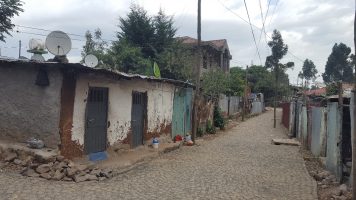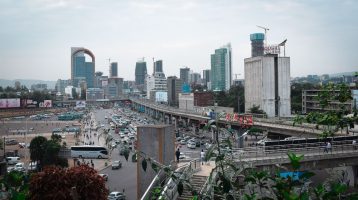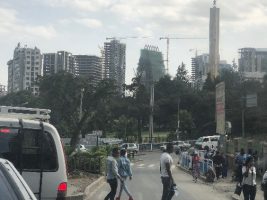Addressing Slums in an Age of Rapid Urbanization
The views expressed are those of the author and do not necessarily reflect the views of ASPA as an organization.
By Nathan (Natan) Teklemariam
October 29, 2018

A typical side street and housing conditions in Addis Ababa, Ethiopia.
The United Nations General Assembly designated the October 31 as World Cities Day. It is fitting that I briefly discuss my current research, which focuses on rapid urbanization in developing countries and the need for solutions to informal settlements and sustainable housing policies in this edition of PATimes.

The sign of rapid urbanization in Addis Ababa viewed from its skyline, elevated light rail system, and automotive and human traffic at its most prominent central square.
According to UN Department of Economic and Social Affairs’ (UN DESA) 2018 World Urbanization Prospects report, 55 percent of the world’s population today lives in urban areas, a proportion that is projected to increase to 68 percent by 2050. To put rapid urbanization in context, the global urban population has increased from 751 million in 1950 to 4.2 billion in 2018. The majority of future increases in urban populations is expected to occur in developing countries of Asia and Africa. It is within this context of global urbanization trends that the United Nations found it necessary to include urban development as one of significant importance in its recent 2030 seventeen Sustainable Development Goals (SDGs) agenda. A blueprint to achieve a just and sustainable global future, the SDGs serve as universally agreed targets to meet in solving challenges related to poverty, inequality, climate, environmental degradation, prosperity and peace across the globe.
Member states of the United Nations view rapid urbanization and the many potential challenges it generates to be a fundamental paradigm that needs to be addressed at the global level. So much so, that along with the SDGs, the UN and 170 countries also adopted the New Urban Agenda (better known as Habitat III) in 2016, a complimentary document intended to guide national and local policies on the growth and development of cities through 2036.
Since the 1960s, developing countries across the globe in particular have faced unprecedented rates of urbanization. Perhaps, the most daunting aspect of meeting the lofty targets of SDG Goals and Habitat III are in addressing the already existing and looming challenges in policy making and administrative realms surrounding affordable housing to their growing urban populations. Rapid urbanization has led to uncontrolled and unplanned settlement patterns, resulting in the proliferation of squatter and informal settlements, and, when extreme, the explosion of large-scale urban areas designated as “slums.” According to the UN-HABITAT’s Slum Almanac 2015/2016 report, one in eight people live in slums, accounting for around one billion people living in slum conditions across the globe today.

The on-going construction boom of buildings in the financial district of Addis Ababa.
The definition of slums has evolved, and their true nature makes them the least well understood places in the global sphere. The catch-all term “slum” is used loosely, and its many connotations and meanings, should be questioned. The generalized way in which the term is used to describe all areas of informal settlements at times doesn’t justifiably represent the people or conditions of those living in “slums.” Not all slums are rife with crime and disease, and not all slums are completely off the grid from legal governance. More problematic, the complexity of the terminology of the word “slum” and its connotations, when viewed across nations and languages, cannot be viewed as a word surmising a one-fits-all paradigm to urban settlements. The favelas of Brazil, the ghettos of the U.S. the barrios of Mexico, the shanties of Jamaica and the mabandas of Tanzania are not only different in name, but also in the variety of their informality, yet the term “slum” is used to define them all under one general umbrella. However, there is one commonality in all their forms — they reflect the poverty of the marginalized urban populations of the world.
The interventions to informal settlements and conditions of slums has also been diverse. Slum clearance and resettlement is one intervention that has been utilized extensively across regions and time, and is currently my main topic of research. Cities have used their legal and administrative powers to clear such areas under the guise of urban health regeneration, renewal and beatification, in most cases with no specific relocation and rehousing program afforded to those displaced. A recent extreme example of this top-down approach is Operation Murabatsvina (Operation Clean-up), or its more literal translation meaning “getting rid of the filth” in Zimbabwe. The Report of the Fact-Finding Mission to Zimbabwe to Assess the Scope and Impact of Operation Murambatsvina by the UN Special Envoy of Human Settlements Issues in Zimbabwe in 2005 concluded over 2.4 million people were directly or indirectly affected by the legal policy and administrative actions of the government to clear up mass areas of urban settlements across the country.
It is easy to assume the extreme nature of Operation Musrabstsivna is a story of the developing world. But, let’s remember it was as recent as the generation we live in that the U.S. also traveled upon its own slum clearance and urban renewal program that has now been largely understood to have had mostly a negative generational effect on the poor and minority populations of its own. Jane Jacobs in “The Death and Life of Great American Cities” stated, “cities have the capability of providing something for everybody, only because, and only when, they are created by everybody.”
As we acknowledge the importance of cities, and the efforts of the SDGs and Habitat III, lets also remember that the policies and administrative actions we employ to all members of urban dwellers is economically fair, effective, efficient and equitably just.
Author: Nathan (Natan) Teklemariam is a third year Doctoral student at the L. Douglas Wilder School of Government and Public Affairs at Virginia Commonwealth University. Teklemariam is a 2018 ASPA Founders’ Fellow and a 2018 ASPA International Young Scholars recipient. [email protected]




 (3 votes, average: 4.00 out of 5)
(3 votes, average: 4.00 out of 5)
 Loading...
Loading...
Addressing Slums in an Age of Rapid Urbanization
The views expressed are those of the author and do not necessarily reflect the views of ASPA as an organization.
By Nathan (Natan) Teklemariam
October 29, 2018
A typical side street and housing conditions in Addis Ababa, Ethiopia.
The United Nations General Assembly designated the October 31 as World Cities Day. It is fitting that I briefly discuss my current research, which focuses on rapid urbanization in developing countries and the need for solutions to informal settlements and sustainable housing policies in this edition of PATimes.
The sign of rapid urbanization in Addis Ababa viewed from its skyline, elevated light rail system, and automotive and human traffic at its most prominent central square.
According to UN Department of Economic and Social Affairs’ (UN DESA) 2018 World Urbanization Prospects report, 55 percent of the world’s population today lives in urban areas, a proportion that is projected to increase to 68 percent by 2050. To put rapid urbanization in context, the global urban population has increased from 751 million in 1950 to 4.2 billion in 2018. The majority of future increases in urban populations is expected to occur in developing countries of Asia and Africa. It is within this context of global urbanization trends that the United Nations found it necessary to include urban development as one of significant importance in its recent 2030 seventeen Sustainable Development Goals (SDGs) agenda. A blueprint to achieve a just and sustainable global future, the SDGs serve as universally agreed targets to meet in solving challenges related to poverty, inequality, climate, environmental degradation, prosperity and peace across the globe.
Member states of the United Nations view rapid urbanization and the many potential challenges it generates to be a fundamental paradigm that needs to be addressed at the global level. So much so, that along with the SDGs, the UN and 170 countries also adopted the New Urban Agenda (better known as Habitat III) in 2016, a complimentary document intended to guide national and local policies on the growth and development of cities through 2036.
Since the 1960s, developing countries across the globe in particular have faced unprecedented rates of urbanization. Perhaps, the most daunting aspect of meeting the lofty targets of SDG Goals and Habitat III are in addressing the already existing and looming challenges in policy making and administrative realms surrounding affordable housing to their growing urban populations. Rapid urbanization has led to uncontrolled and unplanned settlement patterns, resulting in the proliferation of squatter and informal settlements, and, when extreme, the explosion of large-scale urban areas designated as “slums.” According to the UN-HABITAT’s Slum Almanac 2015/2016 report, one in eight people live in slums, accounting for around one billion people living in slum conditions across the globe today.
The on-going construction boom of buildings in the financial district of Addis Ababa.
The definition of slums has evolved, and their true nature makes them the least well understood places in the global sphere. The catch-all term “slum” is used loosely, and its many connotations and meanings, should be questioned. The generalized way in which the term is used to describe all areas of informal settlements at times doesn’t justifiably represent the people or conditions of those living in “slums.” Not all slums are rife with crime and disease, and not all slums are completely off the grid from legal governance. More problematic, the complexity of the terminology of the word “slum” and its connotations, when viewed across nations and languages, cannot be viewed as a word surmising a one-fits-all paradigm to urban settlements. The favelas of Brazil, the ghettos of the U.S. the barrios of Mexico, the shanties of Jamaica and the mabandas of Tanzania are not only different in name, but also in the variety of their informality, yet the term “slum” is used to define them all under one general umbrella. However, there is one commonality in all their forms — they reflect the poverty of the marginalized urban populations of the world.
The interventions to informal settlements and conditions of slums has also been diverse. Slum clearance and resettlement is one intervention that has been utilized extensively across regions and time, and is currently my main topic of research. Cities have used their legal and administrative powers to clear such areas under the guise of urban health regeneration, renewal and beatification, in most cases with no specific relocation and rehousing program afforded to those displaced. A recent extreme example of this top-down approach is Operation Murabatsvina (Operation Clean-up), or its more literal translation meaning “getting rid of the filth” in Zimbabwe. The Report of the Fact-Finding Mission to Zimbabwe to Assess the Scope and Impact of Operation Murambatsvina by the UN Special Envoy of Human Settlements Issues in Zimbabwe in 2005 concluded over 2.4 million people were directly or indirectly affected by the legal policy and administrative actions of the government to clear up mass areas of urban settlements across the country.
It is easy to assume the extreme nature of Operation Musrabstsivna is a story of the developing world. But, let’s remember it was as recent as the generation we live in that the U.S. also traveled upon its own slum clearance and urban renewal program that has now been largely understood to have had mostly a negative generational effect on the poor and minority populations of its own. Jane Jacobs in “The Death and Life of Great American Cities” stated, “cities have the capability of providing something for everybody, only because, and only when, they are created by everybody.”
As we acknowledge the importance of cities, and the efforts of the SDGs and Habitat III, lets also remember that the policies and administrative actions we employ to all members of urban dwellers is economically fair, effective, efficient and equitably just.
Author: Nathan (Natan) Teklemariam is a third year Doctoral student at the L. Douglas Wilder School of Government and Public Affairs at Virginia Commonwealth University. Teklemariam is a 2018 ASPA Founders’ Fellow and a 2018 ASPA International Young Scholars recipient. [email protected]
Follow Us!